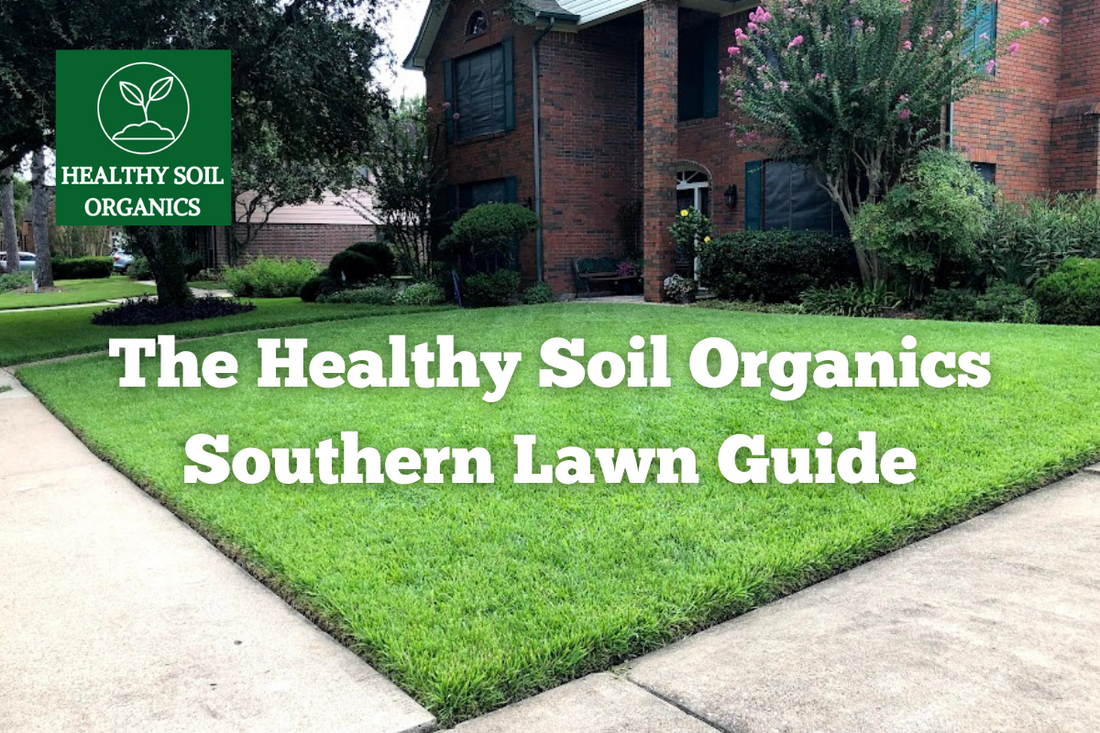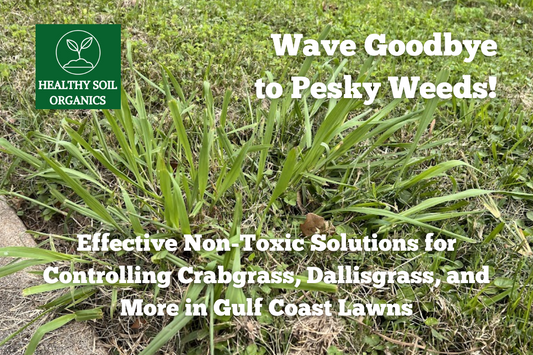
The Healthy Soil Organics Southern Lawn Guide
Jason OstermayerShare
Welcome to the HealthySoilOrganics Southern Lawn Guide, your go-to resource for achieving a lush, vibrant lawn in the Gulf Coast area. This guide is designed to provide you with a comprehensive understanding of lawn care, focusing on three key cultural practices: Feeding the Soil, Maintaining the Lawn, and Watering the Lawn. Let's dive in!
Spring, Summer, and Fall: Seasonal Bundles for a Year-Round Healthy Lawn
Our Annual Lawn Program features three season-specific bundles designed to nourish your lawn throughout the year:
🌸Spring Lawn Bundle: Kickstart Your Organic Lawn Journey
When to Apply: After the last freeze between February and March, depending on your area.🌱Our Spring Bundle covers up to 4,000 sq ft and includes a 20 lb bag of MicroLife Hybrid 20-0-5 Organic Biological Fertilizer and a 40 lb bag of MicroLife Humates Plus All Organic Biological Soil Amendment. Learn More
☀️Summer Lawn Bundle: Your Organic Oasis Awaits
When to Apply: In the second week of June for a lush lawn by the 4th of July.🌱Our Summer Lawn Bundle covers up to 2,500 sq ft and includes a 40 lb bag of MicroLife 6-2-4 All Organic Biological Fertilizer and a 40 lb bag of MicroLife Humates Plus All Organic Biological Soil Amendment. Learn More
🍂Fall Lawn Bundle: Your Organic Solution for a Thriving Lawn and Garden
When to Apply: Anytime between September and November, preferably at least two weeks before nighttime temperatures dip into the 60s Fahrenheit.🌱Our Fall Lawn Bundle covers up to 2,500 sq ft and comprises a 40 lb bag of MicroLife Acidifier 6-2-4 and a 25 lb bag of MicroLife MicroGro Bio. Learn More
Maintaining the Lawn: Cultivating a Thriving Ecosystem
Proper lawn maintenance is essential for a flourishing landscape. Here are some tailored guidelines to help you maintain a healthy, weed-free lawn:
- For St. Augustine Grass: Set your mower deck to 4" above the driveway. This height allows the grass to grow taller, thereby shading out competing Bermuda grass.
- For Bermuda Grass: Maintain a cut height of 2". Cutting Bermuda too short can harm the soil and its microbiome.
- For Zoysia and Fescue Grasses: A cut height of 3" is recommended for optimal results.
- Mowing Frequency: Aim to mow at least every 7 days. Frequent mowing encourages your grass to thicken, helping to choke out any unwanted plants.
- Mower Blade Maintenance: Sharpen your mower blades annually for a cleaner cut, which is healthier for your grass.
- Alternate Mowing Paths: Change your mowing direction each week to encourage new pathways for grass growth.
- Grass Clippings: Mulch the clippings back into the lawn. They contain nitrogen, which your lawn needs for growth.
- Weed Management: For persistent weeds like crabgrass and dallisgrass, manual pulling is the most effective and eco-friendly method.
Watering the Lawn: The Science of Hydration
Watering is a critical component of lawn care, but it's essential to strike the right balance to prevent overhydration or dehydration. Here are some best practices for effective lawn watering:
- Timing: The optimal time for watering is early in the morning or late in the evening when temperatures are cooler, reducing water loss due to evaporation.
- Frequency: Watering every day is not recommended. Instead, aim for deep, infrequent watering to encourage deeper root growth.
- Amount: Apply approximately 1 to 1.5 inches of water per week, either through rainfall or supplemental watering. Use a rain gauge or a small container to measure the amount of water applied.
- Soil Test: Periodically check the soil moisture by inserting a screwdriver or soil probe. If it goes in easily, your lawn has sufficient moisture; if not, it's time to water.
- Automatic Sprinklers: If you use an automatic sprinkler system, ensure it's calibrated correctly to avoid overwatering or underwatering.
The Fundamentals of Our Program: A Natural Approach to Lawn Care
Understanding the core principles of our program is essential for achieving a healthy, vibrant lawn. Here are some key facts that underpin our approach:
- Eco-Friendly Philosophy: We don't promote killing anything. Our approach aligns with Mother Nature, focusing on nurturing the soil and its microbiome rather than using harmful chemicals like fungicides, herbicides, or pesticides.
- Carbon's Crucial Role: Carbon is the building block of life and a microbe's best friend. Our fertilizers are rich in carbon, which serves as a foundation for trillions of microbes, thereby nourishing your lawn.
- The Power of Sugar: Our fertilizers contain molasses, a sugar rich in micronutrients. This supports the symbiotic relationship between plants and soil microbes, enhancing the vitality of your lawn, especially in shady areas.
- Soil Porosity and Water Retention: Healthy soil retains moisture effectively. Our program improves soil porosity, allowing for better water penetration and less runoff, ultimately requiring less frequent watering.
- Long-lasting Fertilizers: Unlike water-soluble chemical fertilizers that wash away, our organic biological fertilizers build up in the soil over time. This means you can gradually reduce fertilizer use as your soil becomes self-sustaining.
By following the guidelines outlined in this comprehensive guide, you'll be well on your way to achieving a lush, vibrant lawn that aligns with ecological principles. Get started with the HealthySoilOrganics.com Annual Lawn Program now and take advantage of our season-specific bundles, priced at a 20% discount to encourage you to follow this program.



